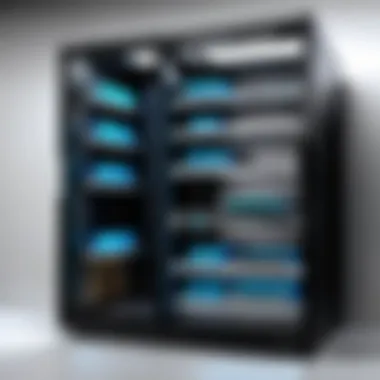Maximizing Efficiency with Network Cabinet Shelves


Intro
In today's fast-paced tech landscape, the way we organize our technology infrastructure is more than just a matter of tidiness; it's about efficiency and accessibility. Network cabinet shelves play a pivotal role in this organization. They're like the unsung heroes of the tech world, quietly ensuring everything stays in its place.
When a server room brims with equipment, chaos can quickly reign. But with the right shelving solutions, you can optimize both space and performance. The goal? To provide tech enthusiasts, casual consumers, and gamers alike with a comprehensive understanding of what makes a great network cabinet shelf. We will delve into various aspects of these components, exploring their features, installation considerations, and benefits while touching on industry best practices. Ultimately, this article aims to empower readers to make informed decisions about equipment used in networking environments.
Understanding Network Cabinets
In the realm of technology, network cabinets serve as the backbone of a seamless infrastructure. They create organized environments for housing equipment like servers, switches, and routers, ensuring that everything runs smoothly. Understanding these cabinets is crucial since they directly impact the efficiency and accessibility of the components stored within them. A proper network cabinet setup can mean the difference between a functional network and a tangled mess of cables and devices.
Definition and Purpose
A network cabinet is essentially a protective enclosure that helps house and manage a variety of network devices. Think of it as a sophisticated storage unit specifically designed for tech gear. Its primary purpose is to provide a secure space that can protect equipment from environmental factors, like dust and moisture, as well as unauthorized access. These cabinets contribute greatly to the overall functionality of a tech setup, maintaining both order and ease of use.
Whether it’s a small office or a large data center, the right network cabinet can help streamline operations, making it easier to install, connect, and maintain various devices. They also play an integral role in cooling, as proper airflow is vital for equipment longevity and performance.
Types of Network Cabinets
When considering network cabinets, it’s essential to recognize that there’s no one-size-fits-all solution. Different types of cabinets come with distinct characteristics that cater to various needs. The main types to explore are:
Rack-Mount Cabinets
Rack-mount cabinets are designed specifically for devices that need to be installed on a rack. One of their standout features is the standardization of rack units (U), which allows for uniformity when stacking equipment. This characteristic can be a game changer, as it optimally utilizes vertical space, enhances organization, and simplifies access to individual devices.
In addition to their efficiency, rack-mount cabinets are a favored choice amongst tech enthusiasts. The modular design allows for a flexible setup that can be adapted as technology evolves. However, be cautious of the potential downsides: these cabinets can sometimes lack adequate sound insulation and might restrict airflow unless properly ventilated.
Walled Cabinets
Walled cabinets take a more protective approach with enclosed sides and doors. Their main objective is security and protection, which makes them an excellent choice for environments where sensitive equipment resides. The key characteristic of these cabinets is their sturdy material, which safeguards devices from both physical damage and environmental hazards.
Although walled cabinets excel in protection, they may limit airflow and increase heat retention if not designed with ventilation in mind. It’s important to evaluate the cooling needs of your setup before opting for this type.
Open Frame Cabinets
Open frame cabinets offer a unique blend of accessibility and flexibility. Without doors or walls, they are designed for easy access to equipment. This is particularly beneficial for setups that require frequent adjustments. The simplicity of this design helps in reducing clutter and allows for better airflow, which can be crucial for cooling down equipment.
However, one must consider the trade-offs: open frames are more exposed to dust and tampering. For environments where security and dust contamination are less of a concern, open frame cabinets can provide a more versatile and less restricted arrangement for your networking needs.
Significance of Shelving in Network Cabinets
When it comes to network cabinets, shelving often takes a backstage seat in conversations about network organization. However, understanding the significance of shelving can play a crucial role in the efficiency and functionality of any technology setup. Well-implemented shelving solutions streamline access to equipment while ensuring an orderly arrangement of hardware components, contributing significantly to reducing clutter and optimizing workflow. Without a strategy for effective shelving, network cabinets can quickly become a chaotic jumble of wires, devices, and various networking paraphernalia. This article seeks to underscore just how vital proper shelving is in enhancing both the performance and organization of these special environments.
Role of Shelves in Organization
Utilizing shelves inside network cabinets transforms how equipment is organized and accessed. In a neatly organized setup, every gadget has a place of its own, making it easier to locate and service devices when necessary. Shelves serve as the foundation of this organization, and their specific arrangements can be tailored to meet the unique needs of any given system.
Unlike cluttered alternatives where items are stacked on top of one another, shelves provide designated space for different network components. For instance, a fixed shelf specifically designed for heavier equipment can hold switches and routers, while a sliding shelf can be handy for accessibly storing frequently used devices. With a proper shelving arrangement, cables, monitoring tools, and other peripherals can all be neatly organized, reducing the chances of mishaps and maintenance delays.
"A well-organized network cabinet is not just an aesthetic choice; it’s a practical necessity that influences efficiency."
Enhancing Accessibility
Efficient organization does not stop at simply labeling everything and putting it in its place. It also involves ensuring that everything is easily accessible. This is where shelving designs such as adjustable and sliding options come to the forefront. For instance, adjustable shelves allow users to modify space according to their evolving needs, accommodating devices of varying heights.


In contrast, sliding shelves pull out easily, allowing quick access to devices at the back of the cabinet without the hassle of removing front-row equipment. Imagine trying to troubleshoot a malfunctioning router, only to find it's buried beneath various other devices! If everything is arranged systematically on shelves, trying to get to the right device becomes a walk in the park, not an expedition.
Stability and Safety Considerations
When it comes to shelving, stability is non-negotiable. The safety of both the technology being housed and those who manage it hinges on the sturdiness of shelf systems. Poorly installed or flimsy shelves can lead not only to damaged equipment but also potentially hazardous scenarios.
For instance, a shelf overloaded with equipment could buckle under pressure, causing devices to fall. This is particularly concerning in environments where delicate hardware is present, such as servers susceptible to physical shock. Shelves must be able to support the weight of the devices they hold while maintaining a balanced weight distribution.
In addition, heftier devices such as servers should be mounted at the bottom to lower the center of gravity. Conversely, lighter items can be placed higher up. Following safety guidelines offers a dual benefit: it not only protects the equipment but also guards against accidents involving personnel accessing the shelves.
In summary, the role of shelves in network cabinets stretches far beyond just simple storage; they are key to achieving an organized, accessible, and safe tech environment. Investing time in understanding its nuances can yield significant dividends in operational efficiency.
Types of Network Cabinet Shelves
Understanding the various types of network cabinet shelves is essential for anyone looking to optimize their tech setups. Different styles of shelving cater to unique organizational needs, helping maximize space and efficiency. The right choice of shelves can not only streamline your inventory but also provide easy access to critical equipment. Let’s delve into the main categories of network cabinet shelves: fixed, adjustable, and sliding.
Fixed Shelves
Advantages and Disadvantages
A fixed shelf offers a much-needed sense of stability when dealing with heavier equipment such as servers and switches. The main advantage of using fixed shelves is their robust construction, often able to handle substantial loads without sagging. This reliability makes them a popular choice for environments where equipment needs remain relatively unchanged. However, the downside is their lack of flexibility. Once installed, they aren't easily adjustable without a significant effort. This characteristic means they might not be the best fit if you frequently rearrange your cabinet contents or change the equipment size.
"Choosing a fixed shelf can create a sturdy foundation, but at the cost of adaptability."
Ideal Applications
Fixed shelves work best in situations where equipment is not expected to vary often. They’re particularly well-suited for data centers that host equipment that needs stable positioning, like firewalls or routers. Since they end up being a lasting solution, the energy you invest in installing fixed shelves can pay off in the long run. However, one must consider potential future needs—if predicted equipment changes are expected, fixed shelves might not fulfill those requirements.
Adjustable Shelves
Customization Options
With adjustable shelves, flexibility takes center stage. They often come with a range of height options, allowing users to tailor the shelf positioning based on specific device sizes. The leading benefit is the ability to change arrangements without the need for total overhauls or reinstallations. This adaptability means that as tech evolves, you won’t be stuck with setups that don’t serve your needs. However, one must take care during adjustments, as the structure can sometimes feel less stable than fixed alternatives, especially with heavier equipment.
Versatility in Use
The versatility of adjustable shelves shines in dynamic environments, like tech startups or IT departments that regularly assay new devices. They're a clever choice when varying equipment types are involved, especially in places where space is at a premium. Using adjustable shelves can help to keep your cabinet organized while accommodating future tech acquisitions. Still, one must remember their structure can be less robust under certain circumstances, requiring thoughtful organization.
Sliding Shelves
Operational Efficiency
Sliding shelves bring about a whole new level of convenience. They allow easy access to equipment that might otherwise be hard to reach. By simply pulling the shelf out, users can interact with devices without the hassle of maneuvering around tightly-packed setups. The real efficiency benefit is the time saved during critical phases of operation or maintenance; it makes troubleshooting feel less like a chore and more of a smooth operation. But one should consider the moving parts, as wear and tear on slides may necessitate occasional maintenance.
Considerations for Implementation
When thinking about sliding shelves, their design and installation require careful planning. The sliding mechanism needs ample allowance for movement. This dynamic can become an issue in cramped spaces. However, once properly installed, the usability can greatly enhance overall efficiency. Be sure to assess weight limits and ensure that all equipment remains secure during that sliding process, otherwise you could end up with quite the mess—and no one wants that.
Installation and Setup
Setting up network cabinet shelves might seem like a straightforward task, but don’t let that fool you. It's a vital part of creating organized and efficient tech environments. This phase involves more than just putting shelves up; it’s about strategic planning and execution. The right installation ensures that the equipment functions properly, reduces the risk of damage, and improves accessibility for maintenance or updates.
Pre-Installation Planning


Assessing Cabinet Dimensions
When diving into the world of network cabinet shelves, checking the cabinet dimensions is like measuring twice before cutting wood. You want everything to fit just so. Knowing the actual height, width, and depth of your cabinet saves a lot of aggravation down the road. A snug fit not only maximizes your space but also ensures all your devices can breathe and don’t overheat.
A key characteristic of assessing dimensions involves understanding the clearances. Shelves that are too close to the roof will hinder air circulation, and too narrow of a setup can limit your ability to add new gear in the future. The unique advantage here is keeping your equipment cool and providing room for possible upgrades without a complete rework of your setup. It's practical at its core, proving its worth in any tech space.
Weight Distribution Considerations
Another essential aspect revolves around weight distribution. You have to consider how the load is spread across the shelves; it's not just balancing the books on your study desk. Uneven weight can lead to bends or breakage, which may spell disaster for your devices.
A standout feature of weight distribution is that understanding it contributes significantly to the longevity of your equipment and cabinets. By keeping heavier items lower and organizing lighter devices above, you ensure a smoother layout that is visually pleasing and sturdy. The drawback? A novice might overlook it, risking a complete structural oversight.
Step-by-Step Installation Guide
Tools Required
First things first, before you lift a finger, gather your tools. A clean work area with the right tools is half the battle won. Commonly, you’ll need a level, drill, screws, and sometimes a friend. It’s not exactly rocket science, but those who scramble will probably face hiccups.
What makes gathering tools essential is how they influence efficiency and safety. Using appropriate levels guarantees that your shelves aren’t just haphazardly assembled. A level shelf is a happy shelf, minimizing the risk of equipment sliding or toppling.
Connection and Mounting Techniques
Finally, you’re ready to get your hands dirty. Connection and mounting techniques vary and should fit your shelves' specifications along with the cabinet type. Whether you're employing rails for sliding shelves or brackets for fixed ones, the method plays a significant role in the build-up.
This is where the beauty of secure and accessible mounting comes into play; proper installation reduces shifting or vibrations that could damage sensitive equipment. On the flip side, those unaccustomed might find this a bit daunting. It's a balancing act between feeling confident with your handiwork and stressing over repairing mistakes.
Taking care while planning the installation and setup reinforces the stability and efficiency of your network cabinet shelving. It’s more than just assembling pieces; it’s about creating a structured environment that functions like clockwork.
Best Practices for Maintenance
Maintaining network cabinet shelves is as crucial as selecting the right components in the first place. Effective maintenance optimizes functionality, extends the longevity of the equipment, and ensures that everything operates smoothly. By integrating best practices into your routine, you can avoid unexpected downtimes and keep your tech setup in top shape. Adopting maintenance practices also helps you to stay ahead of any issues before they spiral out of control, saving you both time and money.
Regular Inspections
Check for Wear and Tear
Regularly checking for wear and tear involves looking over the shelves and connections for any signs of aging. Monitoring the integrity of your equipment is a simple yet effective way to safeguard your network cabinet’s performance. Often overlooked, this aspect serves as an early warning system against potential failures. Key areas to focus on include the mounting brackets, weight limitations, and the shelves themselves. The characteristic of vigilance here can’t be understated—proactively addressing minor strains can prevent major mishaps down the line.
"An ounce of prevention is worth a pound of cure."
It’s a beneficial choice to routinely look for signs of damage. The unique feature of proactive inspections is that they allow users to address issues before they impact operations. However, while checking shelves seems like an easy task, it requires a discerning eye; missing even a small crack could lead to more significant problems.
Cleaning Recommendations
Cleaning recommendations emphasize that a clean setup enhances functionality and reduces risks. Dust, grime, and other debris can lead to overheating and malfunction, affecting not just the shelves but the overall network equipment. A consistent cleaning schedule can greatly contribute to mitigating these risks, ensuring your cabinets remain pristine.
The key characteristic here is consistency. Being diligent about cleaning can prevent the buildup of harmful elements that could impair your tech. An advantage is that it takes relatively minimal time and effort to keep things tidy, unlike repairing extensive damage caused by neglect. Nevertheless, it is essential to carefully choose cleaning products that won’t damage your shelves or electronics.
Optimizing Cable Management
Techniques for Orderly Setup
Techniques for orderly setup focus on keeping cables organized to avoid a chaotic mess in the cabinet, which can obstruct airflow and create confusion. Implementing various methods such as cable ties, raceways, or Velcro straps can significantly enhance the organization. Having a neat setup makes troubleshooting and equipment access much easier; searching for the right cable among a tangled web can be a nightmare.


The main characteristic of these techniques is their simplicity and adaptability to your specific needs. They can cater to anything from extensive network setups to smaller, isolated configurations. The unique feature here is that an orderly setup not only looks professional, but it also increases efficiency when upgrades or maintenance are necessary. On the flip side, some methods may require a consistent effort to maintain.
Labeling Systems
Labeling systems are invaluable for tracking which cables connect to what devices, making troubleshooting far more straightforward. It can be a game-changer when you need to quickly identify components. Clear labels provide easy access to information that can save time and lessen frustration.
The key characteristic here is clarity. A good labeling system stands out—using color codes or unique identifiers ensures you can see at a glance which equipment you’re dealing with. It is a beneficial choice for network maintenance since it streamlines various processes. The unique feature is that it fosters an organized environment; however, consistency in updating labels when changes occur is vital. Forgetting to maintain labeling can lead to confusion when equipment changes or upgrades are made.
In summary, embracing best practices for maintenance not only ensures longevity and reliability but also sets a professional standard in networking environments. This approach benefits everyone involved by making them easier to navigate and maintain.
Evaluating Price and Quality
Evaluating the price and quality of network cabinet shelves isn’t just a stroll in the park. It’s a crucial aspect that could either make or break the efficiency of your entire setup. Investing in the right shelving can directly influence not just the organization of your network but also its longevity. Poor choices can lead to needing replacements frequently, and let’s face it, that can be a headache down the road. Here, we’ll unpack various elements you should consider when making these evaluations.
Understanding Budget Constraints
When it comes to budgeting, every penny counts. For tech enthusiasts, casual users, or even gamers, it’s vital to pinpoint how much you’re realistically willing to shell out for shelves. You'd wanna balance keeping costs low while not sacrificing quality.
Here are some considerations:
- Define Your Needs: Are you looking for heightened durability or just something to get by? Knowing what you need helps narrow down options.
- Consider Long-Term Costs: Sometimes, a slightly higher initial investment saves more in the long run. A shelf that’s built to last could spare you those recurring costs of replacements.
- Factor in Extra Features: Adjustable shelves might cost more but could provide greater versatility for your gear.
A well-planned budget can prevent impulsive buys that lead to buyer's remorse—and no one wants that.
Assessing Shelf Durability
Durability shouldn't be taken lightly. Your shelves are cradles for significant hardware, so they need to bear their weight without flinching. Prioritizing durability means avoiding flimsy materials that buckle under pressure.
Think about these aspects when assessing:
- Material Composition: Steel is typically more robust than plastic. Check what frame materials manufacturers use.
- Weight Capacity: Every shelf has a maximum load it can handle. Know that limit to prevent future mishaps.
- Environmental Resistance: If you're in a humid area, consider how materials might hold up. Corrosion could be a silent killer for your setup.
It's not just about durability—it's about ensuring your investment is wasted on inadequate shelving.
Comparing Different Manufacturers
The market's flooded with options. You got brands here, brands there, and figuring out which ones are worth your time can be like finding a needle in a haystack.
When evaluating different manufacturers, consider:
- Reputation: Do your homework. Companies with longstanding histories or favorable reviews often deliver quality products.
- Warranty and Support: A good warranty can serve as a safety net. It’s reassurance that the manufacturer has confidence in their product.
- Customer Feedback: Visit platforms like Reddit for community insights. Real users can provide valuable feedback on their experiences.
In summary, assessing price and quality ultimately comes down to making well-informed choices that align with your specific needs. Skipping this step can lead to dire consequences in the form of wasted funds and time. Remember, investing wisely in the right network cabinet shelves can maximize your network's potential.
Culmination
The conclusion of this article emphasizes the multifaceted importance of network cabinet shelves in streamlining the organization and efficiency of technology structures. Shelving systems serve as foundational elements that not only optimize space but also ensure that equipment remains accessible and secure. The careful selection of shelving can lead to significant improvements in operational functions, reducing clutter and enhancing airflow, which are crucial for the long-term durability of your networking gear.
Summarizing Key Points
Reflecting on the various sections explored, the primary takeaways from this article include:
- Understanding Different Types of Shelves: We discussed fixed, adjustable, and sliding shelves, detailing their specific advantages and suitable applications. The choice of shelf directly impacts both organization and convenience.
- Installation and Setup Insights: Effective installation is paramount. By assessing cabinet dimensions and planning weight distribution carefully, users can prevent potential issues arising from misalignment or overloading.
- Maintenance Practices: Regular inspections and optimized cable management were highlighted as essential practices. Clean and organized cabinets not only improve aesthetics but also minimize downtime due to equipment failure.
- Evaluating Price and Quality: Understanding budget constraints while comparing manufacturers helps makes informed purchasing decisions. It's essential to invest in shelves that not only fit the budget but also stand the test of time.
Future Trends in Network Shelving
As technology evolves, so do the trends in network shelving. Here are some anticipated developments to keep an eye on:
- Sustainability: Expect to see a shift towards materials that are both eco-friendly and durable. Brands are likely to innovate in sourcing recyclables for shelf construction, reducing waste and environmental impact.
- Smart Shelving Solutions: With the rise of IoT, smart shelving is set to become a reality. Imagine shelves that can track and report usage, alerting you when equipment needs maintenance or replacement.
- Customization and Modularity: Future shelves might cater to a more modular design, allowing users to configure their shelving systems with extreme flexibility according to varying needs.
- Enhanced Cable Management Features: New designs might include integrated cable management systems that enhance airflow and reduce cable clutter, further improving the operational efficiency of networking environments.



